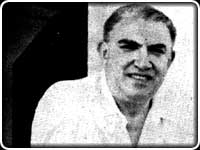|

It
may be said that the “Concert for Prince Eugene” has the composer's cultural
and moral preferences stowed away in it with his dedication to them scaled in
the title. Bruni Tedeschi, a scholar of history and art, thoroughly Piemontese
of a certain period of Savoyan history of European significance, a passionate
researcher and historical and art collector, confesses to seeing the figure of
Prince Eugene of Savoy Soissons rising to his full glory within these spheres,
that of one of the greatest commanders of history, triumphant in Zenta, Turin
and Belgrade, fulcrum of the wars of succession in the torturous years of the
17th/18th century in Europe. A statesman of the policy of the balance of power,
who was of a balanced nature to the very core, he was interested in quite
diverging intellectual, practical and aesthetic fields. He combined the gifts
of courage with refinement and modesty, energy and honesty with a loving heart.
He also was famous as a patron of art and culture, and in the long period of
peace which followed the long period of battles he also initiated the
endeavours in the humanities to attain beauty and sublimity, fostering
relationships with authors and scientists and collecting pictures and works of
art himself. Alberto Bruni Tedeschi sees in the awakening call of Prince Eugene
the epitome of the 18th century with respect to political and heroic virtues
combined with chivalry and fine qualities almost amounting to a Sun King in
Vienna with all the advantages and flaws which led to the French Revolution e.g.
to the new century. Hence the artist of today, seeing an ideal goal in such a
figure, projects himself into a special level of corresponding feelings in
order to express a state of feeling in his works which are not dictated by any
previously determined programme nor are they suited to be simple inferences of
militaristic intellect or anything similar.
The
“Concert for Prince Eugene” is a normal instrumental concert in three
movements. the titles of these movements certainly have a flavour of awakening
calls: Introduction - marchsong - battle. The musical progression is a closed
cogwork of disciplined discourse enriched by the inspirational unity, and if
the discourse has a trace of roughness and difficulty then it is merely the
general musical quality of this composer, which shows its purest and clearest
intellectual relationship application in this composition. Here and there a
clear reference to militaristic colouration appears, which, of course, the
composer intended as a definite battle echo with a Venetian rennaissance
influence, more precisely, a Gabrielan influence. Most clearly presented is the
end of the “battle” with the “Prince Eugene Fanfare”, which was played at his
appearance almost as the standard of the commander-in-chief leading his advances.
It is indeed one of the most beautiful fanfares of the 18th century. It was
also adopted by the cavalry (here one should remember that Alberto Bruni
Tedeschi was an officer of the cavalry), and finally by the Italian
Gendarmerie. The repetition occurs twice at the end of the piece and thus
confirms positively and ideallistically the dedicaton.
|




|
